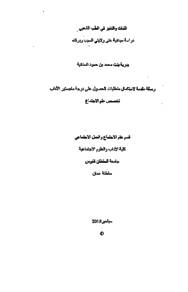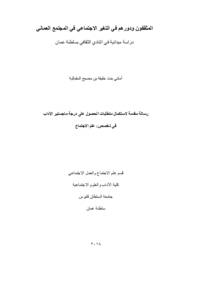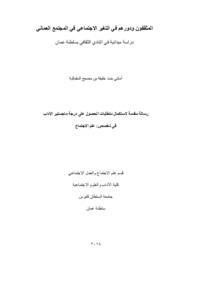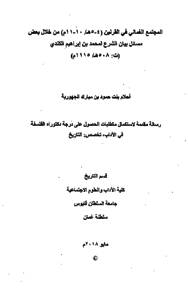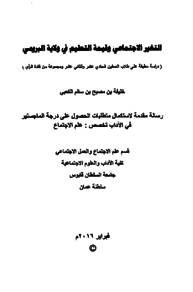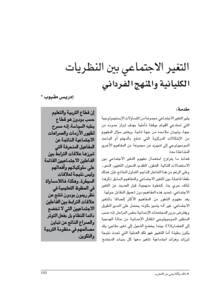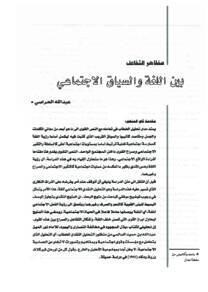Document
الثبات و التغير في الطب الشعبي
Other titles
دراسة ميدانية على ولايتي السيب و بركاء
Publisher
جامعة السلطان قابوس
Gregorian
2018
Language
Arabic
Subject
English abstract
The objective of this study is to identify the Continuity and change in some practices of folk medicine in the Omani society. The main objective is to achieve four sub-goals: to identify the socio-demographic characteristics of the folk therapists and those who seek the traditional medicine; to understand the reason why people in the and finally society use folk medicine; to monitor some practices of the folk medicine to detect the continuity and change in the practice of folk medicine. The study was based on some of the issues of the updated nes- functional approach the issues of the symbolic Internationalism. The study relied on the descriptive approach. It combined quantitative and qualitative methods whenever possible. It was based on a sample convenience of the population of Al-Seeb and Barka states. The sample consisted of 130 individuals. The study used interviews and which included a number of quantitative and qualitative questions. a questionnaire «The field study yielded many findings through the study's sub- themes summarized as follows: The first theme is about the reasons for the community members to resort to folk medicine. It shows that more than half of the total sample resorted to the folk therapy and finally for beautification purposes. « a means of preventing diseases for treatment · available around them«People seemed to prefer it because it is a natural source safer than official medicine and it used by all social groups and not only one cheaper category. The results of the second theme "Some practices of folk medicine": The study indicates that half of the total sample believes that the folk treatment practices are men capable of treating the diseases which modern medicine cannot. It was also perceived that that the folk treatment practices are widely used in our Omani society. folk treatments are influenced by the availability of medical services in Furthermore it was found that popular treatment practices do not have any side «the society. Also effects. The most are - according to the opinion of the samples Popular treatment practices fractures - cuppings herbal treatments then treatment with the Koran ablation treatment and incision for jaundice. " "some features of stability and change in folk therapy" As for the third axis the results indicate the continuity of the majority of popular treatment practices and the relative stability of the function of the folk medical format in treating diseases. It is noted that folk medicine as a practice remains in spite of the development of tools and therapeutic devices. The fact that folk medicine modern medical methods has maintained its place in the community can be a result of its tangible therapeutic benefits. It may also be due to religious or socio-cultural aspects that ensured the continuity and success of folk medicine practices to this day, there are some indicators that suggest a relative Otendency to However change. This change is in the sense of preference for the use of formal medicine in some cases.
There were changes also in some folk treatment practices such as herbal some methods and tools of cupping and others. Furthermore« fracturestreatment some remedial practices have developed. This may be due to the availability of a combination of factors that have led to a change in the general pattern of the Omani such as folk «society. This change has thus been reflected in some sub-patterns economic conditions of the medicine. These factors are the improvement of the socio society. The change was evident in the popular treatment practices associated with witchcraft which led to the disappearance of some of these practices. Some of such «and sorcery
while the folk medicine based on natural practices disappeared in certain areas methods is widely used and is an important therapeutic and preventive part in the format of folk medicine. The study ended with a discussion of the results in the light of previous studies and the theoretical frameworks and presented the main suggestion
in conjunction with the mechanisms of their implementation.
Member of
Resource URL
Arabic abstract
تهدف هذه الدراسة إلى الكشف عن ملامح الثبات والتغير في بعض ممارسات الطب الشعبي في سياق خصوصية المجتمع العماني، ويندرج تحت الهدف الرئيسي أربعة أهداف فرعية هي: التعرف على الخصائص الديموغرافية الاجتماعية للمعالجين الشعبيين والمترددين على الطب الشعبي، والكشف عن أسباب لجوء أفراد المجتمع للطب الشعبي، ورصد بعض ممارسات الطب الشعبي، وأخيرا محاولة الكشف عن الثبات والتغير في ممارسات الطب الشعبي.
استندت الدراسة على بعض قضايا الاتجاه الوظيفي المحدث، وقضايا النظرية التفاعلية الرمزية، واعتمدت الدراسة على المنهج الوصفي، وقد جمعت بين الطرق الكمية والكيفية كلما أمكن ذلك، وطبقت الدراسة على عينة (متاحة) من سكان ولايتي السيب وبركاء، حيث شملت العينة 130 مفردة، وتمثلت أداة الدراسة في المقابلات الميدانية، وصحيفة الاستبار التي تضمنت عددا من الأسئلة الكمية والكيفية. وقد أسفرت الدراسة الميدانية عن العديد من النتائج عبر محاور الدراسة، تلخصت في الأتي: المحور الأول: "أسباب لجوء أفراد المجتمع للطب الشعبي"، حيث أشارت النتائج إلى أن أكثر من نصف إجمالي العينة يلجؤون إلى العلاج الشعبي من أجل العلاج، ثم استخدامه وسيلة الوقاية من الأمراض، وأخيرا استخدامه للتجميل. كما يفضلونه لأنه طبيعي المصدر، وتوافره حولهم، ولرخص ثمنه، وأنه أكثر أمانا من الطب الرسمي، كما أن جميع الفئات الاجتماعية يستخدمون العلاج الشعبي، ولا يختص بفئة واحدة فقط نتائج المحور الثاني: " بعض ممارسات الطب الشعبي "، أشارت الدراسة إلى أن نصف إجمالي العينة يعتقدون أن الممارسات العلاجية الشعبية قادرة على علاج أمراض عجز الطب الرسمي عن معالجتها، وتستخدم الممارسات العلاجية الشعبية بكثرة في مجتمعنا العماني، وتتأثر العلاجات الشعبية بمدى توافر الخدمات الطبية في المجتمع، كما أن الممارسات العلاجية الشعبية ليس لها أي آثار جانبية تذكر، أكثر الممارسات العلاجية الشعبية المنتشرة حسب أراء أفراد العينة هي الكي، ثم العلاج بالقرآن، العلاج بالأعشاب، الحجامة، التجبير للكسور)، الشطب ( علاج بوصفار). أما فيما يتعلق بالمحور الثالث: " بعض ملامح الثبات والتغير في العلاج الشعبي" حيث تشير النتائج إلى استمرارية غالبية الممارسات العلاجية الشعبية والثبات النسبي لوظيفة النسق الطبي الشعبي في مواجهة الأمراض التي يعاني منها أفراد المجتمع، فمن الملاحظ أن الطب الشعبي بوصفها ممارسة ما تزال باقية على الرغم من تطور الأساليب الطبية، والأدوات والأجهزة العلاجية الحديثة، وقد يدلل احتفاظ الطب الشعبي بمكانته في المجتمع المحلي نتيجة لفوائده العلاجية الملموسة، وقد يعود ذلك أيضا لأمور متعلقة بجوانب دينية أو اجتماعية ثقافية ضمنت الاستمرارية والنجاح لأساليب الطب الشعبي حتى يومنا هذا. إلا أن هناك بعض المؤشرات التي تشير إلى ظهور میل نسبي للتغير، بمعنى تفضيل الاستعانة بالطب الرسمي في بعض الحالات، ووجود بعض التغيرات التي طرأت على بعض الممارسات العلاجية الشعبية كالعلاج بالأعشاب أو تجبير الكسور أو الحجامة أو غيرها وتطور طرق وأدوات بعض الممارسات العلاجية، وقد يرجع ذلك إلى توفر مجموعة من العوامل التي أدت إلى حدوث تغيير في النسق العام في المجتمع العماني، ثم انسحب هذا التغيير على بعض الأنساق الفرعية مثل النسق الطب الشعبي، وهذه العوامل تتمثل في تحسن الأحوال في مختلف الميادين الاجتماعية والاقتصادية للمجتمع. حيث ظهر التغير جليا في الممارسات العلاجية الشعبية التي ارتبطت بالسحر والشعوذة والدجل، وادي ذلك إلى اختفاء بعض هذه الممارسات، وبعضها انحسر في بيئات محددة، فيما لا تزال الطرق الشعبية ذات البعد الطبيعي التي تعتمد على الأعشاب الطبيعية مستخدمة بشكل واسع، وتعد جزءا علاجية ووقائية مهما في نسق الطب الشعبي وانتهت الدراسة بمناقشة النتائج في ضوء الدراسات السابقة والأطر النظرية، وعرض أهم المقترحات مقترنة بآليات تنفيذها.
استندت الدراسة على بعض قضايا الاتجاه الوظيفي المحدث، وقضايا النظرية التفاعلية الرمزية، واعتمدت الدراسة على المنهج الوصفي، وقد جمعت بين الطرق الكمية والكيفية كلما أمكن ذلك، وطبقت الدراسة على عينة (متاحة) من سكان ولايتي السيب وبركاء، حيث شملت العينة 130 مفردة، وتمثلت أداة الدراسة في المقابلات الميدانية، وصحيفة الاستبار التي تضمنت عددا من الأسئلة الكمية والكيفية. وقد أسفرت الدراسة الميدانية عن العديد من النتائج عبر محاور الدراسة، تلخصت في الأتي: المحور الأول: "أسباب لجوء أفراد المجتمع للطب الشعبي"، حيث أشارت النتائج إلى أن أكثر من نصف إجمالي العينة يلجؤون إلى العلاج الشعبي من أجل العلاج، ثم استخدامه وسيلة الوقاية من الأمراض، وأخيرا استخدامه للتجميل. كما يفضلونه لأنه طبيعي المصدر، وتوافره حولهم، ولرخص ثمنه، وأنه أكثر أمانا من الطب الرسمي، كما أن جميع الفئات الاجتماعية يستخدمون العلاج الشعبي، ولا يختص بفئة واحدة فقط نتائج المحور الثاني: " بعض ممارسات الطب الشعبي "، أشارت الدراسة إلى أن نصف إجمالي العينة يعتقدون أن الممارسات العلاجية الشعبية قادرة على علاج أمراض عجز الطب الرسمي عن معالجتها، وتستخدم الممارسات العلاجية الشعبية بكثرة في مجتمعنا العماني، وتتأثر العلاجات الشعبية بمدى توافر الخدمات الطبية في المجتمع، كما أن الممارسات العلاجية الشعبية ليس لها أي آثار جانبية تذكر، أكثر الممارسات العلاجية الشعبية المنتشرة حسب أراء أفراد العينة هي الكي، ثم العلاج بالقرآن، العلاج بالأعشاب، الحجامة، التجبير للكسور)، الشطب ( علاج بوصفار). أما فيما يتعلق بالمحور الثالث: " بعض ملامح الثبات والتغير في العلاج الشعبي" حيث تشير النتائج إلى استمرارية غالبية الممارسات العلاجية الشعبية والثبات النسبي لوظيفة النسق الطبي الشعبي في مواجهة الأمراض التي يعاني منها أفراد المجتمع، فمن الملاحظ أن الطب الشعبي بوصفها ممارسة ما تزال باقية على الرغم من تطور الأساليب الطبية، والأدوات والأجهزة العلاجية الحديثة، وقد يدلل احتفاظ الطب الشعبي بمكانته في المجتمع المحلي نتيجة لفوائده العلاجية الملموسة، وقد يعود ذلك أيضا لأمور متعلقة بجوانب دينية أو اجتماعية ثقافية ضمنت الاستمرارية والنجاح لأساليب الطب الشعبي حتى يومنا هذا. إلا أن هناك بعض المؤشرات التي تشير إلى ظهور میل نسبي للتغير، بمعنى تفضيل الاستعانة بالطب الرسمي في بعض الحالات، ووجود بعض التغيرات التي طرأت على بعض الممارسات العلاجية الشعبية كالعلاج بالأعشاب أو تجبير الكسور أو الحجامة أو غيرها وتطور طرق وأدوات بعض الممارسات العلاجية، وقد يرجع ذلك إلى توفر مجموعة من العوامل التي أدت إلى حدوث تغيير في النسق العام في المجتمع العماني، ثم انسحب هذا التغيير على بعض الأنساق الفرعية مثل النسق الطب الشعبي، وهذه العوامل تتمثل في تحسن الأحوال في مختلف الميادين الاجتماعية والاقتصادية للمجتمع. حيث ظهر التغير جليا في الممارسات العلاجية الشعبية التي ارتبطت بالسحر والشعوذة والدجل، وادي ذلك إلى اختفاء بعض هذه الممارسات، وبعضها انحسر في بيئات محددة، فيما لا تزال الطرق الشعبية ذات البعد الطبيعي التي تعتمد على الأعشاب الطبيعية مستخدمة بشكل واسع، وتعد جزءا علاجية ووقائية مهما في نسق الطب الشعبي وانتهت الدراسة بمناقشة النتائج في ضوء الدراسات السابقة والأطر النظرية، وعرض أهم المقترحات مقترنة بآليات تنفيذها.
Category
Theses and Dissertations

